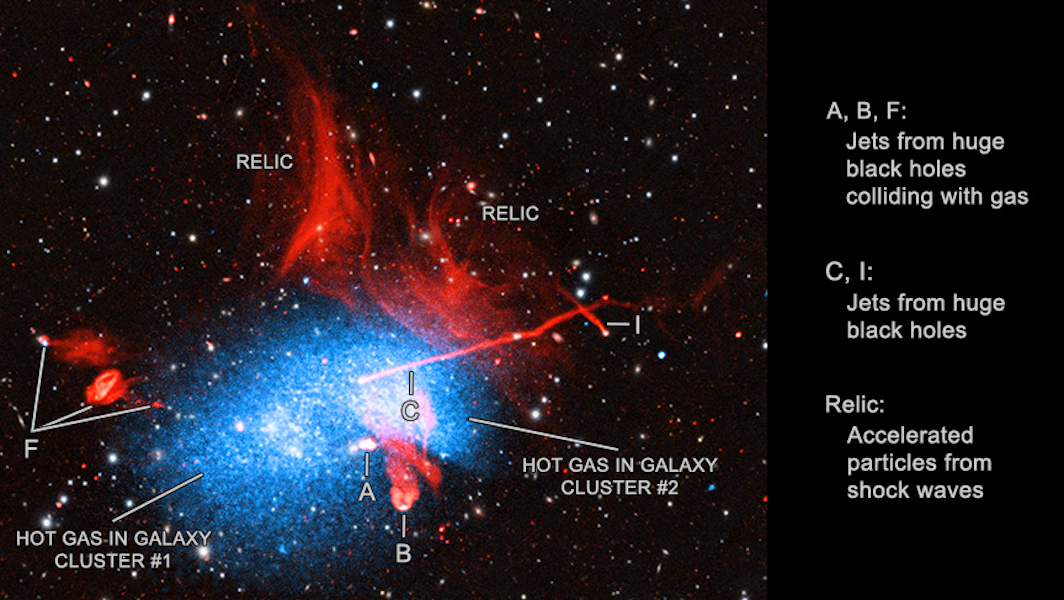
 Credit: X-ray: Chandra: NASA/CXC/Univ. of Bologna/K. Rajpurohit et al.; XMM-Newton: ESA/XMM-Newton/Univ. of Bologna/K. Rajpurohit et al. Radio: LOFAR: LOFAR/ASTRON; GMRT: NCRA/TIFR/GMRT; VLA: NSF/NRAO/VLA; Optical/IR: Pan-STARRS
Credit: X-ray: Chandra: NASA/CXC/Univ. of Bologna/K. Rajpurohit et al.; XMM-Newton: ESA/XMM-Newton/Univ. of Bologna/K. Rajpurohit et al. Radio: LOFAR: LOFAR/ASTRON; GMRT: NCRA/TIFR/GMRT; VLA: NSF/NRAO/VLA; Optical/IR: Pan-STARRS
Reconstructing a Cluster Collision
Clusters of galaxies contain hundreds or thousands of individual galaxies, held together by the mutual binding gravity of their dark matter haloes. Clusters are dynamic, with member galaxies swarming around the common center of mass, and often colliding. Encounters between individual galaxies help drive the high-energy outbursts of the supermassive black holes that most of the galaxies possess and thereby shape the basic building blocks of the structure of the Universe on the largest scales. Even more powerful are collisions between entire clusters of galaxies themselves. A particularly important example of a galaxy cluster collision is the system Abell 2256, a relatively nearby cluster composed of at least three sub-clusters which are falling together.
The image above is a composite of Abell 2256 which includes X-ray emission imaged by the Chandra X-ray Observatory and XMM-Newton (in blue), radio images from the Giant Metrewave Radio Telescope (GMRT), the Low Frequency Array (LOFAR), and the Karl G. Jansky Very Large Array (VLA) (n red), and optical and infrared data from Pan-STARRS (in white and pale yellow). These multi-wavelength studies are vital to produce a full picture of all the energetic process going on when clusters collide. X-ray emission shows the hottest gas which contains most of the mass of atoms and atomic nuclei in the cluster (containing more mass than all the stars in all the cluster galaxies). Optical emission localizes the individual galaxies and reveals the types of stars they contain. Radio emission traces the history of the activity of the supermassive black holes in the cluster, and to reveal how old shocked debris on the outskirts of the collision, in combination with the cluster magnetic field, can accelerate particles to nearly the speed of light. A number of these major features are labelled in the image.
Published: March 6, 2023
<
HEA Dictionary ● Archive
● Search HEAPOW
● Other Languages
● HEAPOW on Facebook
● Download all Images
● Education ● HEAD
>

Each week the HEASARC
brings you new, exciting and beautiful images from X-ray and Gamma ray
astronomy. Check back each week and be sure to check out the HEAPOW archive!
Page Author: Dr. Michael F. Corcoran
Last modified Monday, 26-Feb-2024 17:33:57 EST


